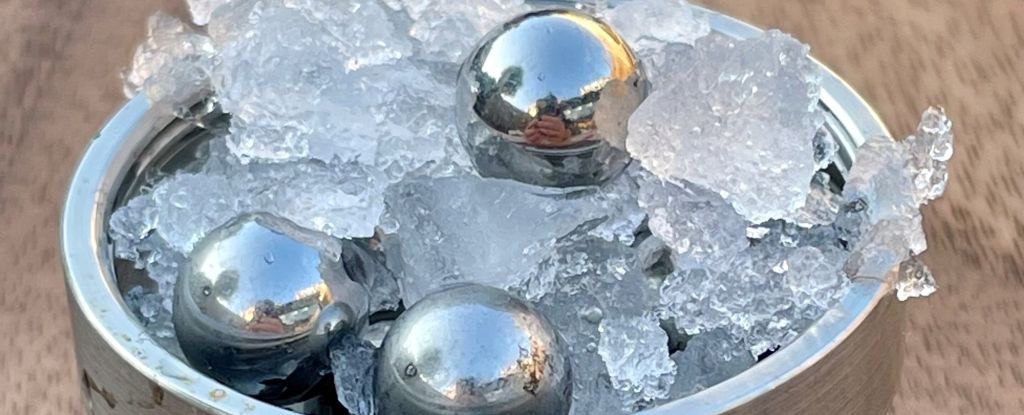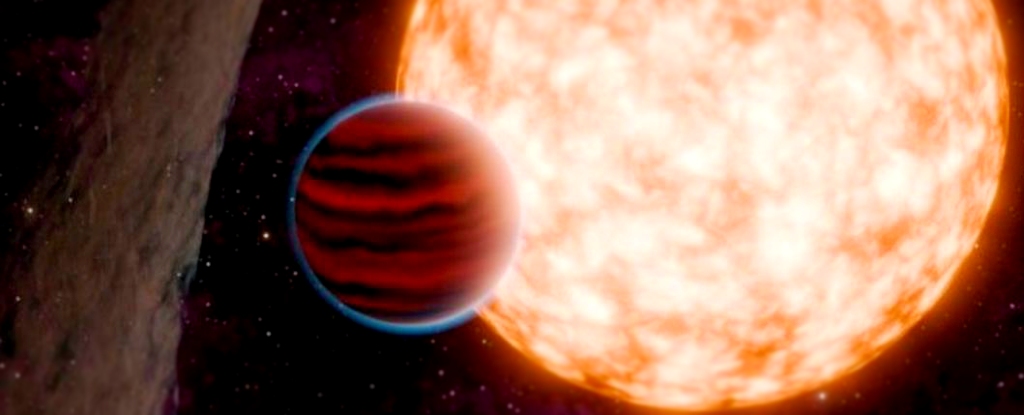Scientists shaking regular frozen water in a jar with ultra-cold steel balls have discovered a previously unknown form of ice that’s closer to liquid water than any other ice to date.
This is amorphous ice, a form not found naturally on Earth. That’s because its atoms aren’t arranged in a clean, repeating crystalline pattern, but jumbled together, an atomic omnishambles.
But the amorphous ice that results from the team’s experiments, a process called ball milling, is unlike any amorphous ice ever seen before.
Amorphous ice typically has a low density, around 0.94 grams per cubic centimeter, or a high density, starting at 1.13 grams per cubic centimeter. The new ice has a density of 1.06 grams per cubic centimeter – which is incredibly close to the density of water at 1 gram per cubic centimeter.
Researchers led by chemist Alexander Rosu-Finsen, formerly of University College London in the UK, have dubbed the new form medium-density amorphous ice (MDA).
“Water is the basis of all life. Our existence depends on it, we launch space missions to look for it, but from a scientific point of view it is poorly understood.” says chemist Christoph Salzmann of University College London.
“We know of 20 crystalline forms of ice, but so far only two main types of amorphous ice, known as high- and low-density amorphous ice, have been discovered. No ice exists within this density gap,” explains Salzmann.
“Our study shows that the density of MDA falls right within this density gap, and this finding may have far-reaching implications for our understanding of liquid water and its many anomalies.”
Water, don’t beat around the bush, is just weird. Because it’s so ubiquitous and necessary to our survival, we don’t think about it much, but it doesn’t follow the same rules as other liquids.
It is a universal solvent; that is, many other substances dissolve in it very easily. Its surface tension is unusually high compared to other liquids, as is its boiling point.
And its density under refrigerated conditions is perhaps strangest of all: when most liquids freeze, their density increases. Water does the opposite: it becomes less dense, meaning water ice is generally less dense than water. That’s why ice cubes float in your drink.
But not all ice cream is the same. Here on Earth, ice naturally takes on a crystalline form, with its atoms arranged in a repeating hexagonal pattern. That’s why snowflakes are usually hexagonal. In the near-vacuum of space, however, ice is usually amorphous because the atoms don’t store enough thermal energy to coil into a crystalline structure.
The density gap in amorphous ice has been quite fundamental to our understanding of water. In fact, previous research and simulations have suggested that the split could mean that at very cold temperatures, water exists as two separate liquids, even coexisting like oil and water, rather than mixing if the conditions are right. Hey, water has done stranger things.
But then Rosu-Finsen and his colleagues caught a few steel balls. ball milling is an industrial technique for grinding or mixing materials. The researchers cooled a grinding jar to -200 degrees Celsius (-328 degrees Fahrenheit) with liquid nitrogen, added regular water ice and shook things up.
“We shook the ice like crazy for a long time and destroyed the crystal structure,” explains Rosu-Finsen. “Rather than end up with smaller chunks of ice, we realized we had come up with something completely new with some remarkable properties.”
What these properties mean is not yet entirely clear. MDA could be a “glassy” state of liquid water, the researchers suggest. Although amorphous ice does not form naturally, other amorphous solids exist; Glass is one of them, and it’s simply a solid form of liquid silicon dioxide. But MDA could also simply be heavily sheared crystalline ice.
It suggests that our existing water models need to be reviewed to see where MDA fits into the picture. But it’s already showing promise for explaining some of the behaviors of water ice in the Universe.
The researchers experimented to see what happens when MDA is recrystallized, compressed and heated. They found that this process releases a surprising amount of energy, suggesting that MDA may play a role in tectonic activity on ice-covered worlds Jupiter’s moon Ganymede.
And the discovery also shows potential for future experiments and studies of the special properties of water.
“We’ve shown that it’s possible to create water that looks like a stop-motion type of water,” says the chemist Andrea Sella of University College London.
“This is an unexpected and quite startling finding.”
The research was published in Science.





